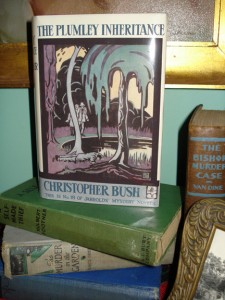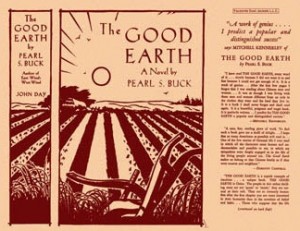 There are thousands of old books out there minus their original dust jackets. Some are first editions, some are not. There are a few talented people who work at restoring the original book covers, front, back, and flaps. Why should used bookshops be interested? A book that is in fairly decent condition and found to be a first but lacking jacket depending on rarity, will fetch a decent price. However, if with original dust jacket, the price skyrockets. Paper didn’t hold up well, and many readers annoyed by the covers would take them off, and leave them off, disposing of them at a later time. Most used bookstores won’t have jacketed firsts laying around, unless they specialize in rare books. But other unjacketed books are plentiful. As are collectors.
There are thousands of old books out there minus their original dust jackets. Some are first editions, some are not. There are a few talented people who work at restoring the original book covers, front, back, and flaps. Why should used bookshops be interested? A book that is in fairly decent condition and found to be a first but lacking jacket depending on rarity, will fetch a decent price. However, if with original dust jacket, the price skyrockets. Paper didn’t hold up well, and many readers annoyed by the covers would take them off, and leave them off, disposing of them at a later time. Most used bookstores won’t have jacketed firsts laying around, unless they specialize in rare books. But other unjacketed books are plentiful. As are collectors.
//
Collectors who although they wish they could afford a jacketed Mary Roberts Rhinehart, would be thrilled to at least have a first with a gorgeous print of the original. And, even if NOT first editions, facsimile jackets fit reprints as well, and make the entire package more marketable. Several crime fiction dealers are using facsimile jackets, always explaining the difference between real and reproduced.

Facsimile Dust Jackets L. L. C. is the company I’ve used for some of first editions I own. They has a massive inventory of fiction, crime fiction, science fiction/fantasy, and a few children’s books. This company came to my apartment a few years back, and scanned many of the books we own to include in their inventory. The Plumley Inheritance in the picture is a facsimile of the first edition of the book. The actual book is as rare as moon cheese. I’ve only seen one copy for sale, and it had been owned by the author! Facsimile Dust Jackets were able to find and obtain permission to scan a copy, and restored the graphics beautifully. I put it upon some uninteresting book, and pretend I own both hardcover and jacket. After all, it is my last name, and I’d sure love an inheritance. The work of this company is amazing. Unless informed, you really couldn’t tell one from the other–but–they have printed on one of the flaps the identity as a facsimile, not original. They never sell a jacket without that fact clearly stated.
Lady Bluestocking Facsimile Dust jackets also do a lovely job.
 Titles from early last century and teens are this company’s strong suit. They have a great deal of knowledge about the artists behind the work, many famous known illustrators of the time, such as Harrison Fisher and Charles Dana Gibson. The inventory has mystery novels as well as popular fiction of the day. I’ve seen titles such as these at used bookstores, rather inexpensive without their rare jackets. With a facsimile, it becomes a show piece.
Titles from early last century and teens are this company’s strong suit. They have a great deal of knowledge about the artists behind the work, many famous known illustrators of the time, such as Harrison Fisher and Charles Dana Gibson. The inventory has mystery novels as well as popular fiction of the day. I’ve seen titles such as these at used bookstores, rather inexpensive without their rare jackets. With a facsimile, it becomes a show piece.
Recoverings reproduces Edgar Rice Burroughs work. All the various genres he worked

in, with Tarzan leading the pack. Another super source for rare dust jacket reproductions.
Prices of the covers vary. The average cost for Lady Bluestocking jacket is $12.00, Facsimile Dust Jackets, $22.00, and Recoverings $25.00.
Naturally the cost of the jacket will raise the price needed to charge for the entire package of book and cover. The price would take into account the jacket cost, the cost of the used book it matches, and the percentage of return the bookseller is looking for. I bought a battered first hardcover of a Merlini mystery, sans jacket, and then matched it with a facsimile. The total cost was approximately $80.00. The bookseller rid himself of a book that had sat on his self for ages, I bought it knowing I could put a facsimile on it-the only reason I bought it–because the boards were simply not that interesting and it wasn’t in the best condition. The jacket cloaks the imperfections and created a show piece within my collection.
I’m in a unique position as I work on scans of various paper ephemera, restoring the pieces of sheet music, post cards, or book jackets to the best of my ability, which is no where in the league of these companies. But I know how long it takes, the skill, the patience and love of illustration that compels them to do it. I appreciate my purchased facsimiles that much more.
I’m not suggesting used bookstores go willy nilly purchasing facsimiles en masse, more in the lines of dipping the toes into a lake to test the temparture. Perhaps invest in a couple covers for titles you match up with a facsimile on a website, and try it out. Display as a focal point in the window, or face out on the shelves.
A collector or non collector whose eye is caught by a vivid Deco cover that piques interest may purchase it based on the facsimile alone. I’ve witnessed it happening. Sometimes judging the book by its cover is a very nice thing indeed.
Websites:
Facsimile Dust Jackets L. L. C.
Lady Bluestocking
http://www.ladybluestocking.com/
Recoverings

We have experimented with a cheap seats version of re-clothing naked books. I bought a shareware program called, simply, Poster. It’s incredibly cheap, $14 or so now. You can download a free trial at CNet.com.
We use it to make posters, banners and signs for the store. But I’ve lately experimented with using 8 x 14 legal paper to make a plain paper dust jacket for books that don’t have one. It’s pretty easy to do–just choose the vertical format and center the book title as it would appear on a normal dust jacket.
You can hand-write in other details, like “1st ed”, publication year, author, maybe sale price in red, anything you want! I plan to gradually do this for all our jacket-free books, because I think it makes it easier for browsing customers to see what’s being offered.
Susan–so what artwork is used on the jackets? No artwork? Even so,
his sounds like really great idea–it does save on the wear and tear on the boards of the book, handling to check pub date etc.
And if there were all the time in the world, yes, that is what bookshop owners have, ha, you could add a jacket blurb of plot–if it’s known.
We sometimes put mylar on unjacketed books, but a paper cover is a much better idea for the data to be related easily.
I got an idea from your reply and tried adding a small image of the original cover to the paper one I made:
http://neonnurse.net/Blogs/ForCaro/badmoon.jpg
It’s not in any way a substitute for the real dust jacket, but then again, no one could possibly think I was trying to palm this off as the genuine article.
Putting a blurb on is a good idea too. Caro says she thinks we could make these with her Publisher program, which WILL let you switch the print different directions (I made this one with two passes through the printer).
I don’t think I would do this for every jacketless book, but now and then we have one that is worth a little extra effort. 🙂
Susan, oh that’s lovely! Really–what a great idea. I also love old illustration–make jewelry from it, so anything that catches the eye is fantastic for bookselling in my mind. The white is fine and that nice graphic on the front creates a elegant touch.
Trying to cover every jacketless book may make your head explode, so yes, a few special ones seem best! LOL.
Where is your store? I’m sure that info is somewhere within the blog, but I’m amazingly lazy!
It’s mostly been Caro writing about our store, Lamar Book Depot, so I can’t blame you for not knowing I’m the Lurking Partner. 🙂
On the other hand, I do some of our web presence stuff on Facebook. It’s a good interface to share pictures. I haven’t done too much with using it to drive sales yet, but I will get there some day!
http://www.facebook.com/pages/Lamar-Book-Depot/146329982047806
There are people that would prefer a paper jacket facsimile over a bare spine on their bookshelves so it comes down to the cost. For some book collectors the cost might not matter but I think for most it would. And, of course, it would be a personal matter to each individual as to what is ‘too much’ and what is ‘acceptable’.
My thought is for a bookstore owner to find what are the best resources for their possible needs of facsimile jackets, post a sign with prices & perhaps keep a sample or two. Some customers might have a book at home that they would be willing to spend the money on. Some might have more than one.
Sounds like a good side item to have available that would only take a bit of space and perhaps be a bit profitable.
prying1–I agree–it’s probably unlikely that a reader would care if there was a gorgeous facsimile on the book, they want to read it, nothing else–which so do I, most of the time, lol.
But there are some who are very visually tuned and may stop and take notice.
But cost is always the factor. If the hardcover the bookshop owner has is a cheap purchase, say 4 bucks, and they match it up with a dust jacket, conceivably they could squeeze triple the book price and cover the cost of the jacket–so-a second edition of say, Footprints on the Ceiling, a mystery, is hanging around, and the dust jacket bought for 22 bucks–it could sell for 34.00. Maybe not. It definitely depends on the clientele.
And your idea about a sign with prices is genius! That’s exactly what I did with some in my collection–I checked which ones I wanted the most, and bought them with the idea of adding on with time. But, in order for the bookseller to make a profit from this–they would need to increase the cost of the jacket somewhat.
Still, a good idea, and exactly what I meant about stores just putting their toes in the pond for a look.
Thanks for the nice mention on your site. I’ve been doing these Burroughs facsimiles since 1999 and have enjoyed every minute of it. Not too many years ago the idea of facsimile dust jackets seemed anathema to book dealers, but you do see many a book on Abebooks listed “with facsimile dust jacket” nowadays. All of my customers are collectors who appreciate the care that goes into restoring the art on the jackets and I’m obsessive about it myself. I love trying to bring the paintings back to their original glory.
Also John Anthony Miller at DustJackets.com does facsimile dust jackets.